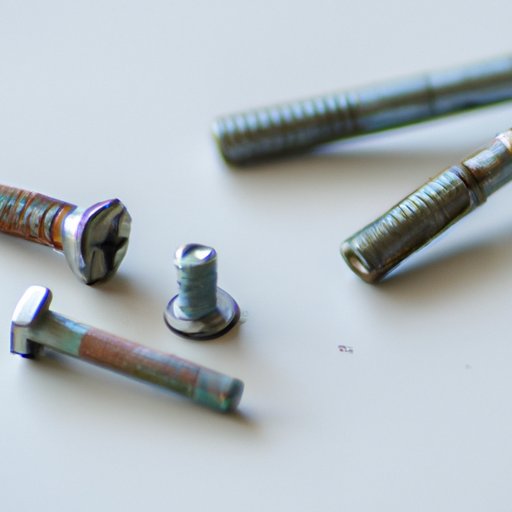
Introduction
There’s nothing more frustrating than trying to remove a rusted, stripped, or sheared bolt. Whether you’re a seasoned mechanic or a DIY enthusiast, broken bolts can bring your project to a screeching halt. Not only are they stubborn, but they can also cause damage to the surrounding area if not removed properly. Removing a broken bolt requires both patience and the right tools, and in this article, we’ll guide you through the process step by step. We’ll also provide tips on preventing bolt breakage, common mistakes to avoid, product reviews, a video tutorial, a Q&A section, and a personal story to keep you engaged.
How to Remove a Broken Bolt
The first step in removing a broken bolt is to assess the damage. Is the bolt flush with the surface or does it protrude? If it’s flush, you may need to drill or file a small indentation to create a starting point for the extractor. Here’s a step-by-step guide to removing a broken bolt:
- Locate the center of the broken bolt and use a center punch to make a dent. This will help guide the drill bit.
- Choose the appropriate sized drill bit and start drilling slowly. Apply steady pressure and avoid using excessive force.
- Once you’ve drilled deep enough, remove the drill bit and insert the extractor into the hole. Make sure it’s seated properly and use a wrench to turn it counterclockwise. The extractor will grip the bolt and turn it out.
- If necessary, use a tap and die set to clean out any debris from the threads.
It’s important to avoid using excessive force as this can cause the extractor to break off in the bolt. Take breaks and use a penetrating oil to loosen the bolt if necessary. Lastly, ensure that the extractor is the correct size for the bolt you’re removing.
Preventing future bolt breakage is essential to avoiding frustration and unnecessary downtime. To prevent bolt breakage, avoid overtightening, use the correct torque settings, and lubricate the bolt before installation. Knowing when to replace a bolt is also important, especially in high-stress applications.
Common Mistakes
One common mistake people make when trying to remove a broken bolt is using the wrong tools. Pliers and wrenches may seem like a quick fix, but they often cause the bolt to strip or round out. Another mistake is using too much force, which can cause the bolt to break further or damage the surrounding area.
An alternative method to using an extractor is to weld a nut onto the remaining bolt shaft. This is especially useful for bolts that have broken off near the surface. The heat from the welding process can help loosen the bolt, and the nut provides a gripping surface for removal.
Product Review
There are several bolt extractors on the market, each with their own pros and cons. We’ve reviewed three popular ones below:
- Irwin Hanson Bolt Extractor Set: This set includes five extractors that work with hexagonal or rounded bolts. They have a reverse spiral design that provides maximum gripping power. The only downside is that they’re not compatible with square-headed or deeply recessed bolts.
- Crescent Bolt Extractor Set: This six-piece set has a fluted design that works well with damaged or tightly embedded bolts. They’re made from high carbon steel and have a black oxide finish for durability. The only downside is that they’re not very effective on small bolts.
- Ontel SpeedOut: This five-piece set is compact and easy to use. They have a double-sided design that works with all types of bolts and screws. The only downside is that they work best with bolts that are not tightly embedded.
It’s important to choose an extractor that works best for your specific bolt situation. Researching the different types of extractors and reading reviews can help you make an informed decision.
Video Tutorial
For a more hands-on approach, we’ve created a video tutorial on removing a broken bolt. In the video, we’ll go over the tools needed, safety precautions, and additional tips and advice.
Q&A
Here are some common questions about removing broken bolts:
- What do I do if the bolt is rusted? Applying a penetrating oil can help loosen the bolt. You can also try tapping the bolt lightly with a hammer to break up the rust.
- What if I can’t reach the bolt? Using an extension can help you reach hard-to-reach bolts. A socket swivel adapter can also help you access bolts in tight spaces.
- When should I use heat to help remove a bolt? Heat can help expand the metal and loosen the bolt. However, it should only be used as a last resort and with caution. Heat can cause damage to surrounding areas and increase the risk of injury.
Personal Story
I once encountered a stubborn broken bolt while working on my car’s transmission. Despite my best efforts, I couldn’t remove it with an extractor or welding a nut onto it. I ended up using a blowtorch to heat up the surrounding area and was finally able to remove the bolt with a wrench. It taught me the importance of using the right tools and being patient in the face of adversity.
Conclusion
Removing a broken bolt can be a daunting task, but with the right tools and techniques, it can be accomplished with ease. Remember to take breaks, use the correct extractor, and be patient. Preventing future bolt breakage is also important, so make sure to use the correct torque and lubrication. Use the techniques and tools discussed in this article to successfully remove broken bolts and keep your project moving forward.





